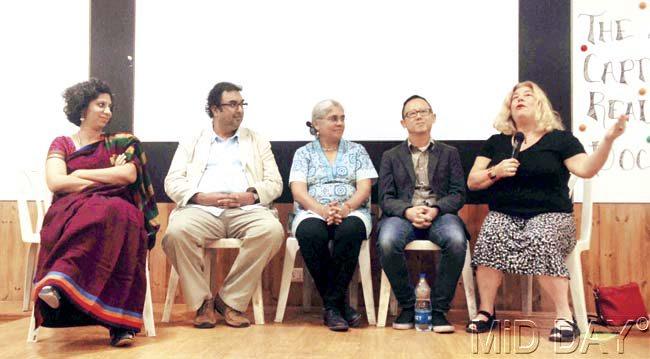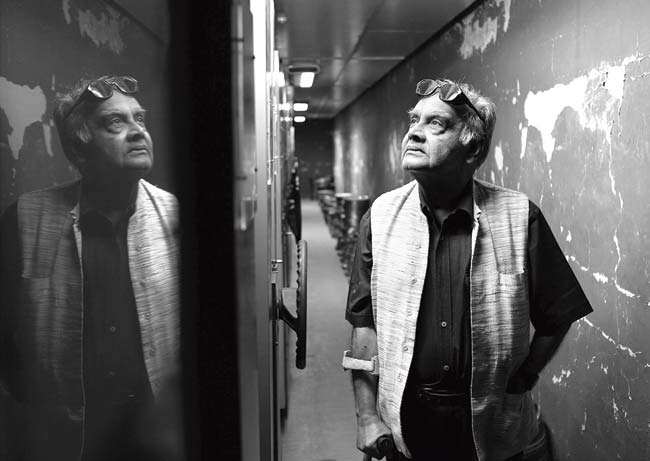A panel discussion on documentary filmmaking ended up taking a good hard look at the financials of the genre

The theme was ‘The Art of Capturing Reality in Documentary’, but the discussion took on a life of its own, as can happen in the creative sphere, and ended up debating the economics of documentary filmmaking. The panel discussion was organised last week in the city by Women in Film & Television (India), along with the US Consulate General.

(L-R) Surabhi Sharma, Shivendra Singh Dungarpur, Anjali Monteiro, Patrick Shen and Debra Zimmerman at the panel discussion held at St Andrew’s College in Bandra last week. Pic/Atul Kamble
On the panel were Debra Zimmerman, Executive Director of non-profit group Women Make Movies, filmmaker Patrick Shen (both from the US), and Indian filmmakers Surabhi Sharma and Shivendra Singh Dungarpur. The discussion was moderated by Anjali Monteiro, Dean, School of Media and Cultural Studies at the Tata Institute of Social Sciences.

A still from Celluloid Man, made by Shivendra Singh Dungarpur
Invisibility of women
Zimmerman said that Women make Movies (WMM) was set up to “put cameras into the hands of women who otherwise do not have the opportunity to make films”, and after some years it had taken to distribution. The main problem WMM faced was funding, she said, and distribution addressed that. It now distributes mainly documentary films, and hopes to address the invisibility of women both behind the camera and on screen.

A still from Surabhi Sharma’s film Bidesia in Bambai
Explaining what she meant, Zimmerman that there are many organisations interested in the gender of the person making the film, but there is a dearth in the US of images of women, not just in documentary but in Hollywood too. Eighteen per cent of camera time is all that is actually spent by women on screen, she said, adding that unfortunately documentaries screened on public television and cinemas in the US also largely represented men and men’s problems, which are considered to be the universal problems, with women’s problems seen as a minority issue or ‘special interest’.
Ultimately, Zimmerman remarked, regardless of the medium even considering the advantages of digital what it always comes down to is marketing. It’s the cost of getting the film to people, so that they know about it, and that is a challenge that continues till today, she said. For example, she said, though iTunes is widespread, the company Apple has controlled the market in such a way that they don’t allow smaller companies to have their own platform.
Documentary as art
Patrick Shen said that documentary is an art form and ultimately art is a reflection of the creator. He said his documentaries are truthful to the extent that his perception of the world and his version of the truth is true. “Ultimately, our version is a metaphor for what is happening in the world,” he said.
He said one of the questions he had been tackling was how to make the documentary more immersive and experiential for the viewer. People don’t want to pay money to go and see something depressing. They want to be moved, to feel compelled, he said, quoting Michael Moore who recommends that filmmakers should not make documentaries, but should make movies.
Shivendra Singh Dungarpur remarked that when he was making Celluloid Man, his documentary about legendary film archivist PK Nair, the medium became important in an odd way. Nair had been approached by many to make a film, “but he agreed to mine because we were shooting on (35mm) film”.
He said Celluloid Man came about after a Martin Scorsese interview led him to visit Bologna in Italy where great films are restored. When he saw the films he remembered from his youth, he said, he realised how much of his student life had slipped away in the bustle of the commercial work he was doing.
Hence, he said, he went to visit P K Nair in Pune, and the film’s journey began. “When I was shooting it, I never thought I was shooting reality. I was always in the magical moment of those personal memories. And if this is documentary, then so be it.” He said making the film was expensive, but because his work as a commercial filmmaker was doing well, he was able to meet the costs.
Perception of gender
Surabhi Sharma said that she came from an unusual batch in the FTII, as there were nine women and two men in the 11-strong class, and the men termed it the death of filmmaking. The difficulties she faced as a filmmaker, she said, included the perception that as a woman filmmaker, she should make films primarily about women. Funding just does not come for films made by women about men, she said, and this placed further constraints in an already difficult area.
It is central as a filmmaker not to be defined by your identity, she said. For example, she said, she made a film in 2007 about music by Indians in Jamaica and Trinidad, where there is a large Indian diaspora, and she pitched the project to the BBC, but she was asked why anyone in the UK would be interested in a film about Indians in Trinidad. “Hence you are bound by a vision that is expected of you. As a filmmaker in these past 10 years it has meant that I don’t get funds very easily!”
Boxed in
Moderator Anjali Monteiro remarked that one of the common themes is that filmmakers are put into boxes which make them more easily marketable. There is a notion of the target audience, or what people want, which shapes the flow of funding, and unfortunately also begins to shape the kind of documentaries that are made. In the Indian context, she said, a lot of Indian documentary filmmakers have struggled both for funding their films and also for showing and distributing them.
Zimmerman further said that when her organisation had studied how US foundations were giving grants, they found that men making films about men got the most money, and women making films about women got the least. But interestingly enough, she said, women making films about men got more money than men making films about women did. The subject has a lot to do with how much money a film gets, she said.
Sharma remarked that in a world of hyper-media, from 24x7 news channels to the ultimate intrusion of programmes like Bigg Boss, everything seems excessive and every detail of life is scrutinised, and as a documentary filmmaker she wants to retreat, to have the choice of not shooting excessively, not following a character through and shooting everything. She said sometimes she wishes 35mm film was still in use so that people would shoot less. “Why one puts the camera on and why one puts it off itself has become a deeply political act now,” she said.
Dearth of avenues
Dungarpur brought up the question of documentary film screenings, and said that in the era of privatisation, documentary filmmakers had very few avenues in which to show their films. Funding restrictions apart, people also don’t want to pay to see documentary films, he said.
There is a culture of watching documentaries in an informal setting, though there is not yet a way to monetise this, said Sharma. She remarked that she receives requests for showing her films from wide-ranging audiences in different parts of India, and so the number of people watching films and discussing them, whether in educational institutions or film societies or other organisations, is sizeable. “Of course, there is no money coming in from that,” she said.
Shen said it is a lot of work, convincing people of the value of the film and that they should pay at least the screening cost. There is this unspoken consensus that you should not have to pay to watch a documentary. “They’ve made it for our benefit, we should not have to pay for it.” Sharma said that even just setting up a film screening costs money, but very often filmmakers were unable to recoup costs as low as even Rs 3000.
 Subscribe today by clicking the link and stay updated with the latest news!" Click here!
Subscribe today by clicking the link and stay updated with the latest news!" Click here!









